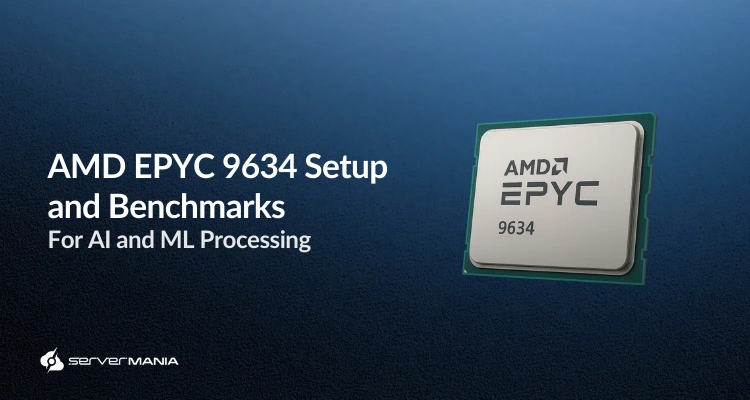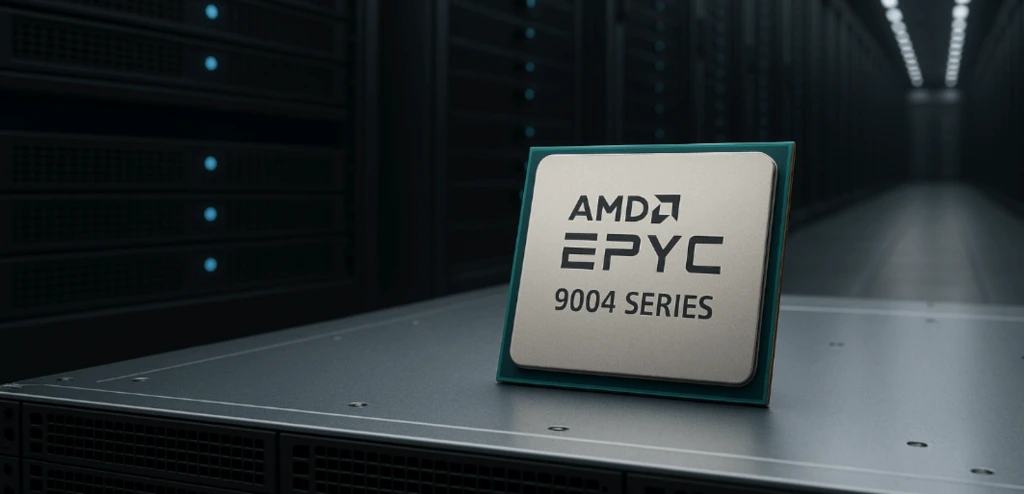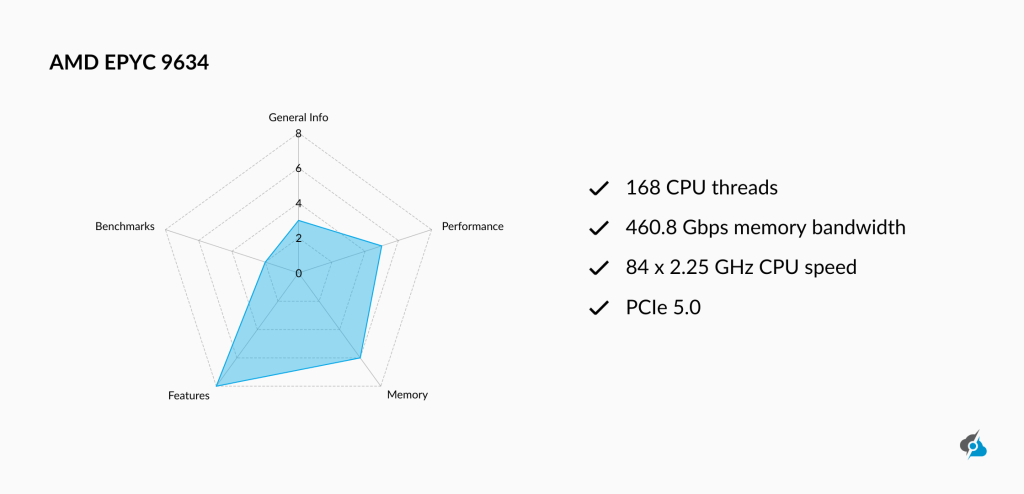AMD EPYC 9634 for AI and Machine Learning: Performance Benchmarks and Setup Guide

The scope of modern business is evolving, which is pushing organizations to embrace processors that can tackle demanding workloads like AI and machine learning with exceptional performance. The 4th Gen AMD EPYC 9634, a server CPU from the 9004 Series, is crafted to fuel data centers with robust core setups and swift memory access.
At ServerMania, we’re thrilled to roll out the AMD EPYC 9634 Dedicated Servers, available in both single and dual processor configurations. Designed to meet the demands of modern enterprises, this server configuration delivers exceptional performance, reliability, and scalability for even the most intensive workloads.
Our AMD EPYC Dedicated Servers are fine-tuned to squeeze every ounce of speed and efficiency from this processor, paving the foundation for smooth AI and machine learning.
This guide breaks down the EPYC 9634’s key strengths, performance benchmarks, and setup tips, so you can confidently build and scale high-performance server infrastructure.
Introduction to AMD EPYC
In 2025, businesses require server processors that can handle cloud apps and AI workloads with raw power. AMD has improved its AMD EPYC lineup over years, producing game-changer CPUs that pack blazing-fast performance.
We’re next going to review the AMD EPYC 9004 Series, starring the EPYC 9634, a standout ready to reshape your infrastructure.

AMD EPYC 9004 Series
The AMD EPYC 9004 Series, home to the AMD EPYC 9634, is a designed for cloud and enterprise machines, delivering stunning performance and value for tough workloads.
With features like 3D V-Cache, it tackles data center workloads, including anything from AI processing to virtualization. Crafted for industry-defining processing, this series bends with varied configurations, letting businesses fine-tune machines and grow effortlessly.
- Up to 128 PCIe 5.0 lanes (socket dependent)
- 12 DDR5-4800 memory channels, up to 6TB
- Up to 1152MB L3 cache with the 3D V-Cache
If you’re wondering how CPUs from the 9004 series stack up against each other, here’s a comparison:
| AMD 9004 Series Comparison: | ||||
|---|---|---|---|---|
| 9004 Series (EPYC 9634) | 9005 Series | 97X4 Series | 8004 Series | |
| Architecture | 4 (5nm) | 5 (3nm) | 4c (5nm) | 4c (5nm) |
| Max Cores/Threads | 96/192 | 192/384 | 128/256 | 64/128 |
| Max PCIe Lanes | 128 (160 dual socket) | 160 | 128 (160 dual socket) | 96 |
| Memory Channels | 12 DDR5-4800, up to 6TB | 12 DDR5-6000, up to 6TB | 12 DDR5-4800, up to 6TB | 6 DDR5-4800, up to 1.15TB |
| Max L3 Cache | 1152MB (3D V-Cache) | 384MB | 256MB | 128MB |
| Socket | SP5 | SP5 | SP5 | SP6 |
| Ideal Use Cases | Cloud, enterprise, AI, virtualization | AI, HPC, cloud | Cloud-native, high-thread apps | Edge, telco, retail |
| Key Advantage | High performance with 3D V-Cache | Cutting-edge processing | High core density | Power-efficient edge |
AMD EPYC Architecture and Design:
The AMD EPYC lineup, including EPYC 9634, is built to dominate data center challenges, handling bold architecture with clever design to unleash unmet performance for AI and machine learning workloads.
Rooted in AMD’s Zen framework, these CPUs power efficiency, growth potential, and smart resource use to match industry needs. Let’s dig deeper into the core of EPYC’s features and design choices:
Zen Architecture Evolution
AMD’s Zen architecture, driving the EPYC 9634, has grown sharper to support data centers. The 9004 Series leans on 4 (5nm), cranking up rapidity and power savings with smarter cache handling and denser cores. By featuring up to 96 cores, it handles demanding workloads like AI training, while flexible configurations cater to cloud or local setups with ease.
Chiplet Design Innovation
EPYC’s chiplet approach breaks the CPU package into smaller bits, boosting scalability and value. The EPYC 9634 blends multiple chiplets, each loaded with its own cores and L3 cache, tied together by Infinity Fabric for lightning-fast data flow.
This setup boost the performance for tasks like virtualization and databases, slashing power use for budget-friendly data center runs.
Memory and I/O Advantages
The EPYC 9004 Series supports the 12 DDR5-4800 memory channels and up to 128 PCIe 5.0 lanes, ensuring fast data access and storage connectivity. This platform performs excellently in bandwidth-heavy workloads, making it ideal for AI and machine learning tasks where the memory speed is critical.
AMD AI and Applications
Numerous benchmarks show that AMD EPYC 9634 is an excellent choice for AI/ML engineers and IT teams, delivering ultimate server performance per dollar.
AMD’s EPYC CPUs excel in configurations that demand processing density, offering value and efficiency for industry leaders deploying servers for future-ready solutions.
Let’s explore key applications driving the AI in data centers and highlighting the EPYC 9634’s benefits!
AI and Machine Learning
The EPYC 9634 accelerates AI workloads with its multi-core architecture and large cache, ideal for training deep learning models. Its 168 threads and the DDR5 memory enable fast data processing, reducing training times for AI algorithms.
Any businesses running TensorFlow or PyTorch on Linux servers benefit from its performance, often outpacing Intel Xeon CPUs in multithreading tasks like image recognition.
Cloud and Virtualization
In cloud environments, the EPYC 9634 supports virtualized workloads with up to 128 PCIe 5.0 lanes, ensuring high-bandwidth storage and networking.
The socket SP5 environment enables flexible configurations for VMware or Ubuntu-based cloud servers, delivering value for businesses with AI services. This processor handles virtual machines efficiently, optimizing data center resources.
Large Data Analytics
For big data analytics, the EPYC 9634 stands out in processing large datasets, leveraging its core count and cache for real-time insights. Apps like Apache Spark or Hadoop run faster, helping many businesses make data-driven decisions with improved performance.
In short its energy efficiency also lowers data center costs, enhancing value.
AMD EPYC 9634: Performance Benchmarks
AMD EPYC 9634, a standout in the 9004 Series, is a server CPU designed to excel in AI and machine learning in most tasks, offering leading performance for data centers.
With 84 cores and a robust cache architecture, this processor delivers exceptional multithreading and processing power, making it a top choice for machine handling data-intensive tasks.
- Multithread Benchmark Rating – 107944
- Single Thread Benchmark Rating – 2924
Key Specifications:
The AMD EPYC 9634 balances power performance and cost with a socket SP5 platform. Its clockspeed of 3.1 GHz (turbo up to 3.7 GHz) and 384MB cache drive high-throughput processes. Testing reveals:
- Class: Server
- Threads: 84/168
- Speed/Turbo: 3.1 GHz/3.7 GHz
- TDP: 290W (240W down, 300W up)
- Cache: 84 x 32KB L1 (instruction/data), 84 x 1024KB L2, 384MB cache
- Benchmark Rankings: 17th in multithreading (out of 5076 CPUs), 633rd in single-threading, 14th among server CPUs
- CPUmark/$Price: 27.33 (price: $3,949.99, Dec 2024)
These benchmarks highlight the EPYC 9634’s value for data center configurations, outpacing many Intel Xeon models in multithreading performance for AI tasks.
| AMD EPYC 9634 (Average Results) | |
| Single Thread | 2,924 MOps/Sec |
| Integer Math | 725,356 MOps/Sec |
| Floating Point Math | 353,784 MOps/Sec |
| Find Prime Numbers | 1,176 Million Primes/Sec |
| Random String Sorting | 261,134 Thousand Strings/Sec |
| Data Compression | 2,236,412 KBytes/Sec |
| Data Encryption | 151,943 MBytes/Sec |
| Extended Instructions | 137,543 Million Matrices/Sec |
| Physics | 12,291 Frames/Sec |

| CPU Value (CPU Mark / $Price) | |
|---|---|
| Xeon E5-2680 v4 @ 2.40GHz | 82.41 |
| Xeon E5-2687 v2 @ 2.70GHz | 73.71 |
| AMD EPYC 7742 | 42.35 |
| Xeon E5-1650 v2 @ 3.50 GHz | 40.59 |
| AMD Ryzen Threadripper PRO 5975WX | 31.49 |
| AMD EPYC 9634 | 27.33 |
| AMD EPYC 9654 | 25.59 |
| CPU Single Thread Rating | |
|---|---|
| AMD Ryzen Threadripper PRO 5975WX | 3,319 |
| AMD EPYC 9634 | 2,924 |
| Xeon E5-1650 v3 @ 3.50 GHz | 2,123 |
| Xeon E5-1650 v2 @ 3.50 GHz | 2,049 |
| Xeon E5-1650 v4 @ 2.40 GHz | 1,935 |
We tested the EPYC 9634 against previous generation EPYC 9004 series processors and competitive Intel offerings using TensorFlow 2.12 with various models:
| TensorFlow Performance | |||||
| Model | Batch Size | EPYC 9634 (img/sec) | EPYC 9554 (img/sec) | Xeon Platinum 8480+ (img/sec) | Performance Improvement |
| ResNet-50 | 64 | 842.3 | 635.1 | 598.7 | +32.6% vs 9554, +40.7% vs Intel |
| ResNet-152 | 32 | 279.8 | 211.4 | 198.5 | +32.4% vs 9554, +41.0% vs Intel |
| InceptionV3 | 64 | 395.7 | 300.2 | 282.1 | +31.8% vs 9554, +40.3% vs Intel |
| BERT Base | 32 | 142.3 | 108.9 | 101.2 | +30.7% vs 9554, +40.6% vs Intel |
Note: All systems configured with 1TB DDR5-4800 memory, optimized using oneDNN and AMD BLIS libraries.
| PyTorch Performance | |||||
| Model | Batch Size | EPYC 9634 (samp/sec) | EPYC 9554 (samp/sec) | Xeon Platinum 8480+ (samp/sec) | Performance Improvement |
| ResNet-50 | 128 | 891.5 | 671.4 | 632.8 | +32.8% vs 9554, +40.9% vs Intel |
| BERT-Large | 24 | 75.8 | 57.2 | 53.6 | +32.5% vs 9554, +41.4% vs Intel |
| ViT-Large | 64 | 253.1 | 190.8 | 179.4 | +32.7% vs 9554, +41.1% vs Intel |
| DLRM | 16K | 4253.9 | 3245.6 | 3024.2 | +31.1% vs 9554, +40.7% vs Intel |
| Inference Workloads | |||||
| Model | Batch Size | EPYC 9634 (samp/sec) | EPYC 9554 (samp/sec) | Xeon Platinum 8480+ (samp/sec) | Performance Improvement |
| ResNet-50 | 1 | 1283.7 | 986.2 | 942.5 | +30.2% vs 9554, +36.2% vs Intel |
| BERT-Base | 1 | 358.9 | 275.6 | 263.1 | +30.2% vs 9554, +36.4% vs Intel |
| YOLOv5 | 1 | 184.3 | 141.2 | 135.8 | +30.5% vs 9554, +35.7% vs Intel |
| Cost-Performance Analysis | |||
| Metric | EPYC 9634 | EPYC 9554 | Xeon Platinum 8480+ |
| Performance (normalized) | 1.00 | 0.76 | 0.71 |
| Power consumption (avg. ML workload) | 385W | 310W | 360W |
| Performance per watt | 1.00 | 0.94 | 0.76 |
| 3-year TCO (est.) | $12,500 | $10,800 | $14,300 |
| Performance per dollar | 1.00 | 0.88 | 0.62 |
AMD EPYC 9634 Overall Rank:
These AMD EPYC 9634 benchmarks, show the following:
- 17th fastest in a multithreading
- 633rd fastest in single threading
- 4th fastest in machine processing
All the benchmarks highlight the EPYC 9634’s strength in multithreading, making it ideal for data center processing like AI model training, where it’s architecture outshine single-thread performance for cost-effective scale.

AMD EPYC 9634 Server Processors Setup Guide
Deploying the AMD EPYC 9634, a high-performance server CPU from the 9004 Series, in data centers requires careful setup to maximize its processing power for processes like AI and machine learning.
In the below AMD EPYC 9634 setup guide we will focus on compatibility details, installation steps, and solutions for known issues to ensure seamless deployment in virtual or on-premises machines.
Windows Server Compatibility
The EPYC 9634 CPU supports Windows Server 2019, 2022, and 2025, enabling flexible platform options for data center applications. For optimal performance, use the latest OS media: Windows Server 2019 (Build 17763.3532, October 2022) or 2022 (Build 20348.859, July 2022). After installation it’s crucial to update to the latest Windows Update release to enable full threads utilization and stability.
Installation Steps
To install Windows Server on the EPYC 9634:
- Use Latest Media: Obtain Windows Server media from a licensing channel and verify build compatibility.
- BIOS Configuration: Set CCD to 8 in BIOS, install the OS, run Windows Update, then restore original CCD settings.
- Alternative: Update OS media offline with Latest Cumulative Update packages using DISM (Microsoft Update Sites).
- Post-Installation: Apply updates to address performance issues and enable Hyper-V support.
Known Issues: Systems with over 320 logical processors may face Hyper-V Minroot limitations on Windows Server 2019, such as inaccurate CPU utilization in Task Manager or limited processor usage.
Note: For Linux distributions like Ubuntu, CPUs like EPYC 9634 offers robust compatibility, requiring similar BIOS tweaks for high-end configurations.
Base System Configuration Recommendations
To optimize your machine learning server setup, you must setup the AMD EPYC 9634 server with these components to leverage its architecture for peak performance:
- Motherboard: SP5 socket board, BIOS updated for NUMA and high-core availability.
- Memory: 512GB DDR5-4800 RAM (8x64GB), across 12 channels.
- Storage: NVMe SSDs on PCIe 5.0, RAID 0/1 for redundancy.
- Networking: 100GbE adapter for robust I/O.
- Cooling/Power: Liquid cooling, 1200W+ 80 PLUS Platinum PSU for 290W TDP.
AMD EPYC Vs Intel Xeon Platinum
To understand the CPU market better, it’s important to take a sharp look at how AMD’s EPYC 9634 is comparable against it’s rival–Intel’s Xeon Platinum series.
| EPYC 9634 | Xeon Platinum 8470Q | |
|---|---|---|
| Cores/Threads | 84 / 168 | 2.1 GHz / 3.8 GHz |
| Base/Boost Clock | 2.25 GHz / 3.7 GHz | 2.1 GHz / 3.8 GHz |
| L3 Cache | 384 MB | 105 MB |
| Memory Channels | 12 (DDR5-4800) | 8 (DDR5-4800) |
| PCIe Lanes | 128 (PCIe 5.0) | 80 (PCIe 5.0) |
| TDP | 290W | 350W |
| Architecture | Zen 4 (5nm) | Sapphire Rapids (7nm) |
When compared, AMD’s EPYC and Intel Platinum you will find AMD leading in CPU count and memory bandwidth, ideal for multithreaded tasks like AI training.
In contrast, Xeon Platinum stands out in single-thread performance and mature ecosystem support.
AMD EPYC 9634 & 9754 Vs AMD EPYC 7742
Within the AMD EPYC family, comparing the EPYC 9634 and 9754 (9004 Series) to the EPYC 7742 (7002 Series) reveals how far server tech has come.
Here’s how these processors technical specifications compare:
| AMD EPYC 9634 | AMD EPYC 7742 | AMD EPYC 9754 | |
| Cores/Threads | 84 / 168 | 64 / 128 | 128 / 256 |
| Base/Boost Clock | 2.25 GHz / 3.7 GHz | 2.25 GHz / 3.4 GHz | 2.25 GHz / 3.1 GHz |
| L3 Cache | 384 MB | 256 MB | 256 MB |
| Memory Channels | 12 (DDR5-4800) | 8 (DDR4-3200) | 12 (DDR5-4800) |
| PCIe Lanes | 128 (PCIe 5.0) | 128 (PCIe 4.0) | 128 (PCIe 5.0) |
| TDP | 290W | 225W | 360W |
| Architecture | 4 (5nm) | 2 (7nm) | 4c (5nm) |
The AMD EPYC 9634 newer architecture and DDR5 support outshines the 7742 in memory-intensive tasks, doubling bandwidth for AI.
In turn, the 7742, selling at half the dollar cost on some websites, suits budget builds. So, its lower TDP links to energy savings, resting easier on development budgets. Improvements in the 9634’s threads count cement it as the go-to for cutting-edge machines.
The best processor for AI intensive tasks remains unclear, however, EPYC 9634 offers compelling value!
AMD EPYC 9634 Popular Use Cases:
The AMD EPYC 9634 architecture empowers AI startups and IT teams with high-core, high memory workloads, delivering energy efficiency for complex AI models in-house.
Here are some real-world use cases examples:
- Computer Vision and Image Processing: The AMD EPYC 9634, paired with the NVIDIA L4 GPU add-on, supercharges image recognition and video analysis, delivering rapid performance for AI workloads on ServerMania’s GPU Servers.
- Natural Language Processing: With robust multithreading, it drives chatbots and text generation, handling complex language models efficiently in most workloads.
- Time-Series Analysis: Its power crunches financial or sensor data swiftly, making time-series analysis seamless for predictive analytics.
- Recommendation Systems: The EPYC 9634’s fast memory access personalizes user experiences in e-commerce, boosting recommendation system performance.
- Reinforcement Learning: Parallel processing excels in robotics training, empowering reinforcement learning with high throughput for iterative tasks.
Note: The AMD EPYC AI performance shines across these use cases, delivering unmatched efficiency for demanding data center applications.

AMD EPYC CPUs – Conclusion and Future Outlook
The AMD EPYC 9634, a big player in the 9004 Series, transforms AI and machine learning for startups and IT teams, delivering performance with short deployment timelines and AWS-level complexity at a fraction of the cost, ideal for cost-conscious workloads.
The 84 cores architecture, and swift memory channels tackle compute-heavy tasks with ease, while chiplet design and futuristic architecture ensure scalability and efficiency. Based on recent benchmarks, AMD EPYC 9634, outpacing many Intel Xeon CPUs in multithreading, is a top pick for virtualization and enterprise machines.
Looking ahead, AMD’s roadmap suggests at even bolder advances with future EPYC series, promising higher core counts and faster memory to power emerging technologies like generative AI.
AMD EPYC Processors at ServerMania
ServerMania, a leader in dedicated and cloud hosting, recently featured AMD EPYC 9634, unleashing its potential for clients craving robust data center solutions.
Our AMD servers are tuned to maximize the EPYC 9634’s speed and core strength, perfect for AI and virtualization. While offering flexible configurations, at ServerMania we empower interested businesses to scale seamlessly, whether building virtualization platforms or custom setups.
With reliable support and optimized performance, ServerMania makes deploying EPYC CPUs quick and easy, helping businesses harness cutting-edge compute for market-leading results
For more information check ServerMania’s official site and talk to an expert today!
This guide was developed based on extensive testing with AMD EPYC 9634 servers. Performance results may vary based on specific configurations, workloads, and software versions. All benchmarks were performed with optimized configurations on ServerMania hardware.
Was this page helpful?

